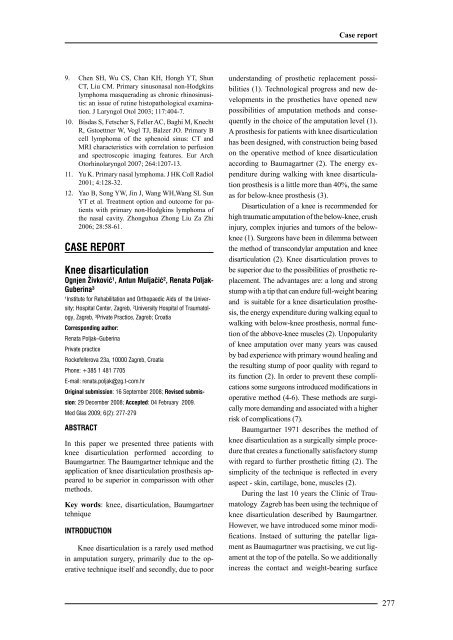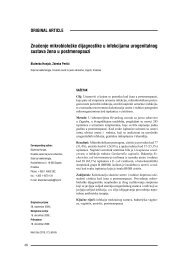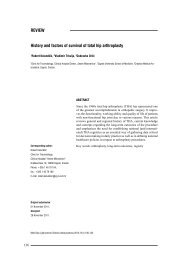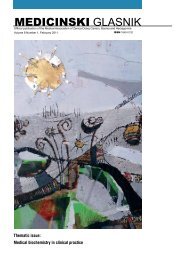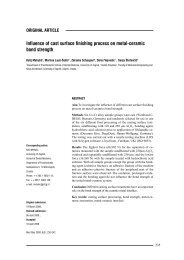MEDICINSKI GLASNIK
MEDICINSKI GLASNIK
MEDICINSKI GLASNIK
Create successful ePaper yourself
Turn your PDF publications into a flip-book with our unique Google optimized e-Paper software.
9. Chen SH, Wu CS, Chan KH, Hongh YT, Shun<br />
CT, Liu CM. Primary sinusonasal non-Hodgkins<br />
lymphoma masquerading as chronic rhinosinusitis:<br />
an issue of rutine histopathological examination.<br />
J Laryngol Otol 2003; 117:404-7.<br />
10. Bisdas S, Fetscher S, Feller AC, Baghi M, Knecht<br />
R, Gstoettner W, Vogl TJ, Balzer JO. Primary B<br />
cell lymphoma of the sphenoid sinus: CT and<br />
MRI characteristics with correlation to perfusion<br />
and spectroscopic imaging features. Eur Arch<br />
Otorhinolaryngol 2007; 264:1207-13.<br />
11. Yu K. Primary nasal lymphoma. J HK Coll Radiol<br />
2001; 4:128-32.<br />
12. Yao B, Song YW, Jin J, Wang WH,Wang SL Sun<br />
YT et al. Treatment option and outcome for patients<br />
with primary non-Hodgkins lymphoma of<br />
the nasal cavity. Zhonguhua Zhong Liu Za Zhi<br />
2006; 28:58-61.<br />
CASE REPORT<br />
Knee disarticulation<br />
Ognjen Živković¹, Antun Muljačić², Renata Poljak-<br />
Guberina³<br />
¹Institute for Rehabilitation and Orthopaedic Aids of the University;<br />
Hospital Center, Zagreb, ²University Hospital of Traumatology,<br />
Zagreb, ³Private Practice, Zagreb; Croatia<br />
Corresponding author:<br />
Renata Poljak–Guberina<br />
Private practice<br />
Rockefellerova 23a, 10000 Zagreb, Croatia<br />
Phone: +385 1 481 7705<br />
E-mail: renata.poljak@zg.t-com.hr<br />
Original submission: 16 September 2008; Revised submission:<br />
29 December 2008; Accepted: 04 February 2009.<br />
Med Glas 2009; 6(2): 277-279<br />
ABSTRACT<br />
In this paper we presented three patients with<br />
knee disarticulation performed according to<br />
Baumgartner. The Baumgartner tehnique and the<br />
application of knee disarticulation prosthesis appeared<br />
to be superior in comparisson with other<br />
methods.<br />
Key words: knee, disarticulation, Baumgartner<br />
tehnique<br />
INTRODUCTION<br />
Knee disarticulation is a rarely used method<br />
in amputation surgery, primarily due to the operative<br />
technique itself and secondly, due to poor<br />
Case report<br />
understanding of prosthetic replacement possibilities<br />
(1). Technological progress and new developments<br />
in the prosthetics have opened new<br />
possibilities of amputation methods and consequently<br />
in the choice of the amputation level (1).<br />
A prosthesis for patients with knee disarticulation<br />
has been designed, with construction being based<br />
on the operative method of knee disarticulation<br />
according to Baumagartner (2). The energy expenditure<br />
during walking with knee disarticulation<br />
prosthesis is a little more than 40%, the same<br />
as for below-knee prosthesis (3).<br />
Disarticulation of a knee is recommended for<br />
high traumatic amputation of the below-knee, crush<br />
injury, complex injuries and tumors of the belowknee<br />
(1). Surgeons have been in dilemma between<br />
the method of transcondylar amputation and knee<br />
disarticulation (2). Knee disarticulation proves to<br />
be superior due to the possibilities of prosthetic replacement.<br />
The advantages are: a long and strong<br />
stump with a tip that can endure full-weight bearing<br />
and is suitable for a knee disarticulation prosthesis,<br />
the energy expenditure during walking equal to<br />
walking with below-knee prosthesis, normal function<br />
of the abbove-knee muscles (2). Unpopularity<br />
of knee amputation over many years was caused<br />
by bad experience with primary wound healing and<br />
the resulting stump of poor quality with regard to<br />
its function (2). In order to prevent these complications<br />
some surgeons introduced modifications in<br />
operative method (4-6). These methods are surgically<br />
more demanding and associated with a higher<br />
risk of complications (7).<br />
Baumgartner 1971 describes the method of<br />
knee disarticulation as a surgically simple procedure<br />
that creates a functionally satisfactory stump<br />
with regard to further prosthetic fitting (2). The<br />
simplicity of the technique is reflected in every<br />
aspect - skin, cartilage, bone, muscles (2).<br />
During the last 10 years the Clinic of Traumatology<br />
Zagreb has been using the technique of<br />
knee disarticulation described by Baumgartner.<br />
However, we have introduced some minor modifications.<br />
Instaed of sutturing the patellar ligament<br />
as Baumagartner was practising, we cut ligament<br />
at the top of the patella. So we additionally<br />
increas the contact and weight-bearing surface<br />
277


